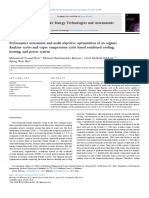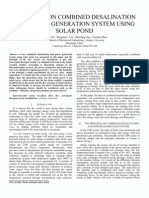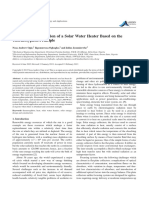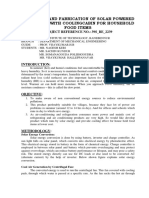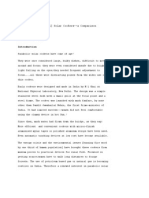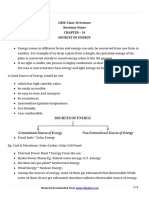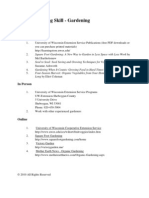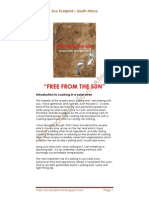Energy Optimiz Ation: Hybrid Solar Cooking With Heat Mass Transfer Control
Energy Optimiz Ation: Hybrid Solar Cooking With Heat Mass Transfer Control
Uploaded by
hgvirus1234512Copyright:
Available Formats
Energy Optimiz Ation: Hybrid Solar Cooking With Heat Mass Transfer Control
Energy Optimiz Ation: Hybrid Solar Cooking With Heat Mass Transfer Control
Uploaded by
hgvirus1234512Original Title
Copyright
Available Formats
Share this document
Did you find this document useful?
Is this content inappropriate?
Copyright:
Available Formats
Energy Optimiz Ation: Hybrid Solar Cooking With Heat Mass Transfer Control
Energy Optimiz Ation: Hybrid Solar Cooking With Heat Mass Transfer Control
Uploaded by
hgvirus1234512Copyright:
Available Formats
feature article
I Z A T I O N OF
Y O P T I M T H H E AT
E R
EN OLAG R C O OK I N
R CO
G WI
N T R O L
Y B R ID S A N S FE
H
A S S TR
M
Prasanna U R and Dr L Umanand
Centre for Electronic Design and Technology, Indian Institute of Science, Bangalore – 560012
I
ndia is currently the world’s fifth According to an Indian government The conventional box type cooker
largest consumer of energy, survey, in 2001, 52.5% of people use design has been studied and modified
accounting for 3.7% of worldwide firewood for cooking, while LPG is since the 1980s and various designs
energy consumption. The energy used by 17.5% of the population. Half and their characteristics have been
for cooking accounts for 36% of of the world’s population is exposed to extensively investigated. Box type
the total primary energy consumption. indoor air pollution, mainly the result cooker with multiple reflectors are easy
The wood cut for cooking purpose of burning solid fuels for cooking and to build but difficult to use for cooking,
contributes to the 16 million hectares of heating. as it has to be done outdoor.
forest destroyed annually. The cooking In this regard, solar cookers are Hot box ovens and concentrating
energy demand in the rural areas of expected to contribute considerably solar cookers are cheap and effective.
developing countries is largely met with towards meeting the domestic cooking However, they are limited to cooking
biofuels such as fuel wood, charcoal, energy requirement in a country like during clear sky periods and require
agricultural residues, and dung cakes, India, which is blessed with abundant the cook to work outdoors in rural
whereas LPG (Liquefied Petroleum Gas) sunshine. On an average, India areas and on roof tops in urban areas.
and electricity are predominantly used receives 5 kWh/day/m2 of sunlight for Though parabolic cookers are used for
in urban areas. Different energy sources more than 300 days of a year. Solar fast cooking, the cooking rate cannot
for cooking have been evaluated and cooker is an environment-friendly and be controlled, and it is potentially
LPG stoves were found to be the most cost-effective device for harnessing hazardous due to the focusing of sun
preferred cooking device in India. solar energy. beam. These types of solar cookers do
OCTOBER 2009 VOLUME 3 ISSUE 2 23
feature article
not provide for interactive cooking,
which is prevalent in the regular cooking
procedures of the Indian kitchen. Solar
cooker has not been readily accepted
by the Indians due to the reason that
cooking has to be done outdoor and
it is completely dependent on the
availability of solar insolaton.
For a solar cooking system to be
accepted and adopted in most of the
households, the following objectives
have to be satisfied.
1. The cooking should be done without Figure 1 Block schematic of the hybrid solar cooking system
moving out of the kitchens.
2. It should reduce the use of The energy extracted from the Sun is heat loss to ambient. Hence, this causes
conventional energy. stored in the buffer tank. The size of lower collector heat transfer. Increasing
3. Cooking can be carried out at any this tank is decided by the amount of the flow rate will not only disturb the
time of day/night. energy that needs to be stored for late density stratification of the fluid in the
4. Time taken for cooking must be night or early morning cooking and storage tank, but also necessitate more
comparable with conventional the amount of energy that needs to energy for pumping the fluid against
cooking. be saved from other energy sources the hydraulic resistance of the pipes,
of the hybrid system. Whenever food even though the heat removal factor
In order to satisfy the above- has to be cooked, the stored energy is improves. There exists an optimal
mentioned objectives, a hybrid solar transferred to the load through the heat flow rate for which it is possible to
cooking technique has been proposed exchanger using pump-II, which varies extract maximum energy from the
and designed, wherein the solar the flow rate of the fluid through the collector. By dynamically varying the
energy is transferred to the kitchen heat exchanger. The auxiliary source flow rate, maximum energy can be
and supplements the conventional of energy like LPG or electrical energy drawn as insolation varies. This optimal
LPG source. is used for supplementing the stored flow rate depends on many factors
solar energy. This also reduces the time like solar insolation, and sizing of
System description and required for cooking, as compared pipe, storage tank, and collector. The
operation to the previously proposed cooking flow rate at which maximum power
The block diagram of the proposed systems like box-type cookers. Energy can be extracted for a given input
cooking system is shown in Figure 1. required from the auxiliary source is to solar insolation also depends on the
The solar thermal collector is in general be optimized for the given system based characteristic of the centrifugal pump.
placed at a high location, preferably on the availability of solar insolation at The MPPT (maximum power point
on the roof top. A cylindrical (linear) the location and the load profile. tracking) controller should sense the
parabolic collector, a paraboloid, or The central goal of the proposed collected power and accordingly vary
a concentrating collector is used to system is to transfer heat from the the flow rate q1 to the optimal value.
collect solar energy and increase the solar collector to the load. There If very small diameter pipes are
temperature of the fluid. The heat are two levels of heat transfer with used, then it increases the hydraulic
exchanger is placed in the kitchen intermediate energy storage in a buffer resistance, resulting in pressure drop
where the cooking is done. It transfers tank. The heat is first transferred from and hence, very poor performance.
heat from the circulating fluid to the the solar collector to the storage tank. On the other hand, if we go for higher
cooking load. All other components are Pump-I controls the fluid flow rate q1 diameter pipes, surface area of the
placed at intermediate levels according to control the heat transfer from the pipe increases, which decreases the
to the building requirements. Pump-I collector to tank. At lower flow rates, conductive and convective thermal
is used to vary the flow rate of the fluid the temperature of the collector and resistance. As a consequence, the
through the solar thermal collector. outlet fluid is higher resulting in higher efficiency of the system comes down
24 VOLUME 3 ISSUE 2 OCTOBER 2009
feature article
Figure 2 Energy flow diagram of the system
due to increase in conductive and which is fixed at the focus of the
Table 1 Temperature set points for
convective heat transfer coefficient paraboloid, as shown in Figure 4. Linear
cooking
between the pipe and the atmosphere. actuator controls the angle of tilt made
Temperature
Thus, for a given location and cooking by the paraboloid in order to track the
in ºC Application
load profile, there exists an optimal pipe Sun continuously.
65 Keeping liquids hot
diameter for which energy extracted is A stainless steel pipe with thermal
85 Simmering of food
maximal. 95 Boiling of food insulation is used to carry hot fluid
Power from the auxiliary source, like 116 Steam pressure cooker from heat storage tank to the receiver
LPG or electrical heater, is controlled 175 Deep frying and back to the buffer tank. The buffer
according to the load requirement and tank is made up of stainless steel and
availability of the stored energy and thermally insulated using mineral wool.
solar energy. Energy taken from this The proposed system is a complex Servotherm oil is circulated through the
source has to be minimized so as to multi-energy domain system concentrator using a rotary gear pump.
optimize the savings of LPG. comprising of energy flow across several On the load side circulation, hot oil is
Figure 2 shows the energy flow in domains such as thermal, electrical, and circulated from the heat buffer through
the described cooking system. Solar hydraulic. The entire system is modelled the heat exchanger using another
thermal collector absorbs solar energy, using the bond graph approach with pump. Temperature sensors are placed
which is used to heat up the fluid. During seamless integration of the power flow at different points to measure the
this process, part of the energy is lost in these domains. It is simulated and the temperature. Flow rate of the collector
to ambient and the remaining energy results are validated experimentally. side and the load side circulation is
is stored in the heat storage tank as measured using two flow meters. Figure
buffer. The heat transferred from solar Design 3, 4, and 5 show the experimental setup
energy to the storage tank is dependent Hybrid solar cooking system is being of the cooking system.
on the flow rate of the circulating fluid. setup to supply the energy requirement
This heat transfer rate is controlled of a canteen near CEDT
by using a hydraulic pump. Energy is (Centre for Electronic Design
transferred from the storage tank to and Technology) at IISc
the load through the heat exchanger. (Indian Institute of Science),
This flow of energy is controlled by Bangalore. Paraboloid
the flow rate of fluid through the heat solar concentrator is used
exchanger. Energy requirement for to raise the temperature
the load, in addition to solar energy, of servotherm oil, which is
is provided by the auxiliary source of used as heat transferring
energy like LPG or electrical energy. fluid. Anodized aluminium
(a) buffer tank, (b) buffer-collector pump, (c) buffer-load pump,
The load temperature requirements of sheets are used to reflect (d) heat exchanger, (e) flow meter
typical Indian households is as follows. sunlight on to the receiver, Figure 3 Experimental setup of the cooking system
OCTOBER 2009 VOLUME 3 ISSUE 2 25
feature article
Results and discussions
Experiments have been carried
out on a small-scale laboratory
prototype as shown in figure
6. The temperature at different
parts of the system is measured.
Experimental results are
compared with the simulation
Figure 4 Solar parabolic collector
results within 5% error. Effective
collector efficiency and overall
system efficiency is calculated
for different flow rates and
different pipe diameters from
the bond graph model as shown
in figure 7 and 8.
Estimated energy savings
Figure 5 Experimental setup
In a typical Indian household of
Figure 6 Lab prototype of the solar cooking
five members, one LPG cylinder
system
lasts approximately a month. One
LPG cylinder containing 14 kg of LPG
contains 170 kWh of energy. Thus, in a
month 170 kWh of energy is utilized for
cooking purposes by a typical Indian
household. A 1m radius paraboloid
has a cross section area of around
3.14 m2 presented to the Sun. At an
average irradiance of 5kWh/m2/day,
the amount of energy incident on the
surface for a month of 30 days is 471kWh.
Considering the collection efficiency as
20% (typical), about 90kWh is available
Figure 7 Variation in effective collector efficiency every month. Thus, the LPG should last
twice as long if used with the proposed
system.
Conclusion
The hybrid solar cooking device has
been designed to bring solar energy
directly to the kitchen. Using heat
storage buffer, cooking can be carried
out at any time of the day or night.
The user need not have to completely
depend on solar insolation, as the
remaining energy is supplied by
conventional source of energy like LPG
or electrical.
Figure 8 Variation in overall efficiency
26 VOLUME 3 ISSUE 2 OCTOBER 2009
You might also like
- Thermal Power Plant Project ReportDocument63 pagesThermal Power Plant Project Reportasutoshjena28173% (26)
- MODELING, OPTIMIZATION AND DESIGN OF A SOLAR THERMAL (PDFDrive)Document245 pagesMODELING, OPTIMIZATION AND DESIGN OF A SOLAR THERMAL (PDFDrive)taguma PEDZISAINo ratings yet
- Experimental Investigation On The Characteristics of The Partitioned Tank Applied To The Solar Air ConditioningDocument4 pagesExperimental Investigation On The Characteristics of The Partitioned Tank Applied To The Solar Air ConditioningSyed Muztuza AliNo ratings yet
- Steam ConsumptionDocument9 pagesSteam ConsumptionSiddhant SatpathyNo ratings yet
- Heat Rate of TG PDFDocument9 pagesHeat Rate of TG PDFTapash Nag0% (1)
- 500 MW BoilerDocument5 pages500 MW BoilerJimsNo ratings yet
- Research On Solar Heating System With Phase Change Thermal - 2016 - Energy ProcDocument6 pagesResearch On Solar Heating System With Phase Change Thermal - 2016 - Energy Procbeauty xuNo ratings yet
- Mapúa University PDFDocument26 pagesMapúa University PDFRodolfo Rey TorresNo ratings yet
- ASME GT2011 45736final LibreDocument8 pagesASME GT2011 45736final LibreGaluh MuhendraNo ratings yet
- MEA 561 Power Plants TUTORIALSDocument12 pagesMEA 561 Power Plants TUTORIALSLue niNo ratings yet
- Design of A Solar Thermophilic Anaerobic Reactor For Small FarmsDocument9 pagesDesign of A Solar Thermophilic Anaerobic Reactor For Small Farmsmarceltubia0No ratings yet
- Ground-Source Heat Pump SystemDocument9 pagesGround-Source Heat Pump SystemIon ZabetNo ratings yet
- BodyDocument69 pagesBodyRoi Benedict BuenaNo ratings yet
- Solar Domestic Hot Water System Analysis Using TrnsysDocument8 pagesSolar Domestic Hot Water System Analysis Using TrnsysflorinrocaNo ratings yet
- ESO 201A: Thermodynamics: Vapor and Combined Power CyclesDocument22 pagesESO 201A: Thermodynamics: Vapor and Combined Power CyclesamanNo ratings yet
- 2008 - BirnbaumDocument9 pages2008 - BirnbaumJoão MarcosNo ratings yet
- Zero Energy HomeDocument8 pagesZero Energy HomeAnđelo MiklićNo ratings yet
- Ocean Thermal Energy Conversion: International Journal of Energy and Power EngineeringDocument4 pagesOcean Thermal Energy Conversion: International Journal of Energy and Power EngineeringKemas Ganesha MahendraNo ratings yet
- Various Plants Used For Generation of Electric Power Hydroelectric, Nuclear and Thermal Energy Plants Parts & WorkingDocument6 pagesVarious Plants Used For Generation of Electric Power Hydroelectric, Nuclear and Thermal Energy Plants Parts & WorkingWilson Fuentes100% (1)
- Geothermal BrineDocument6 pagesGeothermal BrineAchmad HermansyahNo ratings yet
- Air FanDocument6 pagesAir FanDevi PurnamasariNo ratings yet
- Performance Studies On The Reversing Valve Incorporated Air-To-Water Heat Pump With Heat Storage DeviceDocument10 pagesPerformance Studies On The Reversing Valve Incorporated Air-To-Water Heat Pump With Heat Storage DeviceTJPRC PublicationsNo ratings yet
- Applied Energy: U.R. Prasanna, L. UmanandDocument10 pagesApplied Energy: U.R. Prasanna, L. UmanandCheco RockNo ratings yet
- Sustainable Energy Technologies and AssessmentsDocument13 pagesSustainable Energy Technologies and AssessmentsMuhammadAsimNo ratings yet
- High Temperature GeothermalDocument9 pagesHigh Temperature GeothermalbilmardNo ratings yet
- Ijet V2i6p2Document6 pagesIjet V2i6p2International Journal of Engineering and TechniquesNo ratings yet
- 8-17nov JeggelsDocument15 pages8-17nov JeggelsQuynh NguyenNo ratings yet
- A Year in The IfeDocument12 pagesA Year in The IfebahtiyarhocamatNo ratings yet
- J Rser 2011 05 019Document6 pagesJ Rser 2011 05 019ediah004No ratings yet
- Thermal EngineeringDocument10 pagesThermal Engineeringlokeshdhangar842No ratings yet
- Role of Solar Energy in Poultry Houses-1Document30 pagesRole of Solar Energy in Poultry Houses-1MUZAMIL YASINNo ratings yet
- Vapor and Combined Power Cycles: Mehmet KanogluDocument22 pagesVapor and Combined Power Cycles: Mehmet Kanogluichig0_89No ratings yet
- Amulya Gaikwada ProjectDocument34 pagesAmulya Gaikwada ProjectHarikrishna NethaNo ratings yet
- Poweplant Instrumentation Previous Question PapersDocument43 pagesPoweplant Instrumentation Previous Question PapersAnexmechNo ratings yet
- Applied Energy: Brecht Baeten, Frederik Rogiers, Lieve HelsenDocument12 pagesApplied Energy: Brecht Baeten, Frederik Rogiers, Lieve HelsenSindhu KanyaNo ratings yet
- Chapter 10 LectureDocument22 pagesChapter 10 LectureBala MuruganNo ratings yet
- The Study On Combined Desalination and Power Generation System Using Solar PondDocument5 pagesThe Study On Combined Desalination and Power Generation System Using Solar PondSree HariNo ratings yet
- IJRPR9918Document11 pagesIJRPR9918Ranjeet Kr SharmaNo ratings yet
- Performance Optimization of A Combined Solar Collector, Geothermal Heat Pump and Thermal Seasonal Storage System For Heating and Cooling GreenhousesDocument10 pagesPerformance Optimization of A Combined Solar Collector, Geothermal Heat Pump and Thermal Seasonal Storage System For Heating and Cooling GreenhousesAbdelilah HilaliNo ratings yet
- Real-Time Optimization of A Solar-Natural Gas Hybrid Power Plant To Enhance Solar Power UtilizationDocument6 pagesReal-Time Optimization of A Solar-Natural Gas Hybrid Power Plant To Enhance Solar Power UtilizationBORIS KAPLANNo ratings yet
- TF 4 Hot Water SystemDocument17 pagesTF 4 Hot Water SystemMonique SinghNo ratings yet
- Modelling and Simulation of A Hybrid Solar Heating System ForDocument9 pagesModelling and Simulation of A Hybrid Solar Heating System ForÜlkü Serçin SerçinoğluNo ratings yet
- Energies: Investigation of The Performance of A Heat Pump Using Waste Water As A Heat SourceDocument17 pagesEnergies: Investigation of The Performance of A Heat Pump Using Waste Water As A Heat SourceAzfarridzwan MuszaffarshamNo ratings yet
- Tugas Paper Pak DanarDocument15 pagesTugas Paper Pak Danarindra purnamaNo ratings yet
- Unit-2.2 - Solar Power PlantDocument24 pagesUnit-2.2 - Solar Power PlantPrabal SinghNo ratings yet
- 1 s2.0 S0196890417309895 MainDocument14 pages1 s2.0 S0196890417309895 MainLilou MGKNo ratings yet
- Organic FluidDocument8 pagesOrganic Fluidhsrao77No ratings yet
- Smart Hot Chamber in Refrigeration System BasedDocument5 pagesSmart Hot Chamber in Refrigeration System BasedNaveenprabhu VNo ratings yet
- Improving The Performance of Household Refrigerator by Recovering Heat From The CondenserDocument3 pagesImproving The Performance of Household Refrigerator by Recovering Heat From The CondenserIjsrnet EditorialNo ratings yet
- Thermosyphon Principle PDFDocument8 pagesThermosyphon Principle PDFManoj KumarNo ratings yet
- Development of A 200-KW Organic Rankine Cycle PoweDocument5 pagesDevelopment of A 200-KW Organic Rankine Cycle PowedevNo ratings yet
- IV SolutionDocument35 pagesIV SolutionAnonymous t3GcHwKMBNo ratings yet
- Modelling and Fabrication of Solar Powered Air Cooler With Coolingcabin For Household Food ItemsDocument2 pagesModelling and Fabrication of Solar Powered Air Cooler With Coolingcabin For Household Food ItemsSoumyodeep MukherjeeNo ratings yet
- Topic 6 - Regenerative Power Cycle and PlantDocument23 pagesTopic 6 - Regenerative Power Cycle and PlantMike MikeNo ratings yet
- 1999 Nov Multi-Pressure Absorption Cycles in Solar Refrigeration PDFDocument8 pages1999 Nov Multi-Pressure Absorption Cycles in Solar Refrigeration PDFVerma AbhiNo ratings yet
- Chapter - 06 - Second Law-8Document38 pagesChapter - 06 - Second Law-8Marviandi EkoNo ratings yet
- Lecture 8: Steam Generators: Fig. 8.1: A Shell Boiler With An EconomizerDocument6 pagesLecture 8: Steam Generators: Fig. 8.1: A Shell Boiler With An EconomizerIjazzzAliNo ratings yet
- Mechanics of the Household: A Course of Study Devoted to Domestic Machinery and Household Mechanical AppliancesFrom EverandMechanics of the Household: A Course of Study Devoted to Domestic Machinery and Household Mechanical AppliancesNo ratings yet
- Geothermal Energy: From Theoretical Models to Exploration and DevelopmentFrom EverandGeothermal Energy: From Theoretical Models to Exploration and DevelopmentNo ratings yet
- Thermodynamic analysis of geothermal heat pumps for civil air-conditioningFrom EverandThermodynamic analysis of geothermal heat pumps for civil air-conditioningRating: 5 out of 5 stars5/5 (2)
- Parabolic Solar Cookers-A ComparisonDocument5 pagesParabolic Solar Cookers-A ComparisonDr Srinivasan Nenmeli -KNo ratings yet
- MEKELLEDocument142 pagesMEKELLEAmmi AdemNo ratings yet
- Non Conventional Energy Sources Lab: Intermediate Vocational Course Second YearDocument34 pagesNon Conventional Energy Sources Lab: Intermediate Vocational Course Second YearKella HariNo ratings yet
- Solar Cooker AssignmentDocument6 pagesSolar Cooker Assignmentscribdo0o0o100% (1)
- Study of Medium Temperature Solar Thermal Applications: Parimal S. Bhambare, Dr. G. V. ParishwadDocument11 pagesStudy of Medium Temperature Solar Thermal Applications: Parimal S. Bhambare, Dr. G. V. Parishwadyassine633No ratings yet
- CBSE Class 10 Science Revision Notes Chapter - 14 Sources of EnergyDocument9 pagesCBSE Class 10 Science Revision Notes Chapter - 14 Sources of EnergyNeena GuptaNo ratings yet
- BE-2-Solar Cooker SWHs-Amrita ShuklaDocument5 pagesBE-2-Solar Cooker SWHs-Amrita ShuklargpvgateNo ratings yet
- Worksheet 6 12 SolarOven 2Document6 pagesWorksheet 6 12 SolarOven 2830030116No ratings yet
- Study Solar CookerDocument3 pagesStudy Solar CookerSreo Sree Roy ʘ‿ʘNo ratings yet
- Solar Panel Pizza Oven TaskDocument2 pagesSolar Panel Pizza Oven Taskapi-450931716No ratings yet
- C 3 DN 356150245 QSQDocument2 pagesC 3 DN 356150245 QSQapi-282444171No ratings yet
- Provident Living Skills HandoutDocument14 pagesProvident Living Skills HandoutKariWhite100% (3)
- Solar Heated Grill From A Recyclyed Carton Box Focusing On Optics and Renewable EnergyDocument12 pagesSolar Heated Grill From A Recyclyed Carton Box Focusing On Optics and Renewable EnergyAileen Addun100% (1)
- Climate Change Book Future Power - EngDocument23 pagesClimate Change Book Future Power - EngilieoniciucNo ratings yet
- Chapter-2 Various Design of Solar Cooker 2.1 Solar CookerDocument9 pagesChapter-2 Various Design of Solar Cooker 2.1 Solar CookerappannusaNo ratings yet
- Solar CookerDocument26 pagesSolar Cookerd4rkrakeshNo ratings yet
- Thermal Performance Testing of Parabolic Solar Cooker Using New World Standard ProcedureDocument10 pagesThermal Performance Testing of Parabolic Solar Cooker Using New World Standard Procedurerejeesh_rajendranNo ratings yet
- A Simple Solar Water PasteurizerDocument6 pagesA Simple Solar Water PasteurizerAnghel Curty Jr.No ratings yet
- Reflective Materials ReportDocument21 pagesReflective Materials Reportdwimukh360No ratings yet
- Solar Cooker: Advantages of Solar CookingDocument1 pageSolar Cooker: Advantages of Solar CookingHector MompinPNo ratings yet
- Experimental Investigation of Performance of Parabolic SolarDocument15 pagesExperimental Investigation of Performance of Parabolic Solarvincent jancarlo ricarteNo ratings yet
- Solar Cooking ThesisDocument4 pagesSolar Cooking Thesisfc4qgsp7100% (2)
- Ihm-Fuels Used in Catering IndustryDocument7 pagesIhm-Fuels Used in Catering IndustryShariq KhanNo ratings yet
- Introduction To Solar CookingDocument8 pagesIntroduction To Solar CookingEcoFootprintSA0% (1)
- Pathways rw2 2e U2 TestDocument13 pagesPathways rw2 2e U2 TestvalentinaNo ratings yet
- Solar Cooker - A Review Joshi PDFDocument9 pagesSolar Cooker - A Review Joshi PDFjohar MohammadNo ratings yet
- GEDADocument12 pagesGEDAbhagchandt817No ratings yet
- How To Make Solar Cooker and Its WorkingDocument3 pagesHow To Make Solar Cooker and Its Workingmichel.nakhle22No ratings yet
- ND Project Write-UpDocument46 pagesND Project Write-UpKhushee SadaivNo ratings yet
- Lab ManualDocument55 pagesLab ManualBhardwaj UpadhyayNo ratings yet























